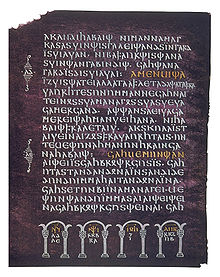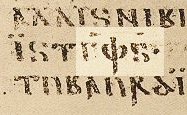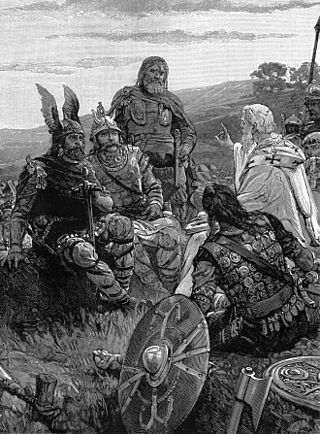
Ulfilas, also spelled Ulphilas and Orphila, all Latinized forms of the unattested Gothic form *𐍅𐌿𐌻𐍆𐌹𐌻𐌰 Wulfila, literally "Little Wolf", was a Goth of Cappadocian Greek descent who served as a bishop and missionary, participated in the Arian controversy, and is credited with the translation of the Bible into Gothic. He developed the Gothic alphabet – inventing a writing system based on the Greek alphabet – in order for the Bible to be translated into the Gothic language. Although the translation of the Bible into the Gothic language has traditionally been ascribed to Ulfilas, analysis of the text of the Gothic Bible indicates the involvement of a team of translators, possibly under his supervision.
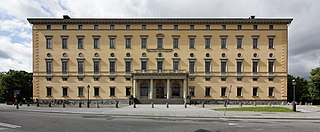
Carolina Rediviva is the main building of the Uppsala University Library in Uppsala, Sweden. The building was begun in 1820 and completed in 1841. The original architect was Carl Fredrik Sundvall. Later additions to the building have been designed by Axel Johan Anderberg and Peter Celsing. The name, literally "Carolina Revived", was given in remembrance of the old Academia Carolina building, which had functioned as the university library for most of the 18th century. Carolina Rediviva is the oldest and largest university library building in the country. It is also the site where the Codex Argenteus and the Cancionero de Upsala are kept.

The Skeireins is the second-longest known surviving text in the Gothic language, after Ulfilas' version of the Bible. It consists of eight fragments of a commentary on the Gospel of John which is commonly held to have originally extended over seventy-eight parchment leaves. It owes its title to the 19th-century German scholar Hans Ferdinand Massmann, who was the first to issue a comprehensive and correct edition of it: "Skeireins" means "explanation" in Gothic. The manuscript containing the Skeireins text is a palimpsest.

The Gothic alphabet is an alphabet used for writing the Gothic language. Ulfilas developed it in the 4th century AD for the purpose of translating the Bible.
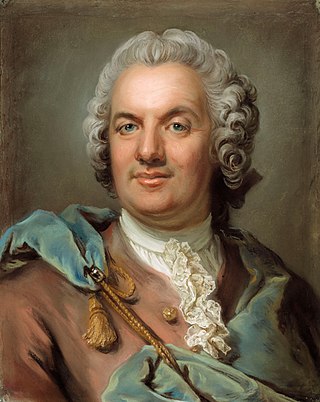
Johan Ihre was a Swedish philologist and historical linguist.

The Uppsala University Library at Uppsala University in Uppsala, Sweden, consists of 11 subject libraries, one of which is housed in the old main library building, Carolina Rediviva. The library holds books and periodicals, manuscripts, musical scores, pictures, and maps.

The Codex Brixianus, designated by f, is a 6th-century Latin Gospel Book which was probably produced in Italy.

Franciscus Junius, also known as François du Jon, was a pioneer of Germanic philology. As a collector of ancient manuscripts, he published the first modern editions of a number of important texts. In addition, he wrote the first comprehensive overview of ancient writings on the visual arts, which became a cornerstone of classical art theories throughout Europe.

The Annolied is an Early Middle High German poem in praise of Archbishop Anno II of Cologne. Anno died in 1075 and the poem, probably written in the years immediately after his death, can be seen as part of a campaign for his canonisation, which was finally achieved in 1183.

The Gothic Bible or Wulfila Bible is the Christian Bible in the Gothic language spoken by the Eastern Germanic (Gothic) tribes in the Early Middle Ages.

Anders Uppström was a Swedish philologist, particularly known for his work on the Codex Argenteus, the manuscript of Bishop Wulfila's Gothic Bible translation held by the Uppsala University Library.

Bonaventura Vulcanius was a Flemish humanist who played a leading role in Northern humanism during the 16th and 17th century. He was a professor of Latin and Greek at Leiden University for 30 years and published various books in the Latin language. He was also a poet.
A biblical manuscript is any handwritten copy of a portion of the text of the Bible. Biblical manuscripts vary in size from tiny scrolls containing individual verses of the Jewish scriptures to huge polyglot codices containing both the Hebrew Bible (Tanakh) and the New Testament, as well as extracanonical works.
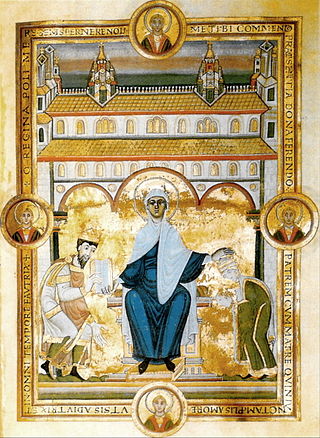
The Golden Gospels of Henry III, also Codex Aureus of Speyer or Speyer Gospels, is an eleventh-century illuminated Gospel Book. The manuscript contains the Vulgate versions of the four gospels plus prefatory matter including the Eusebian canon tables. It was probably produced at the Abbey of Echternach under the patronage of Henry III, Holy Roman Emperor. In 1046, Henry donated the manuscript to Speyer Cathedral to commemorate the dedication of the cathedral's high altar.
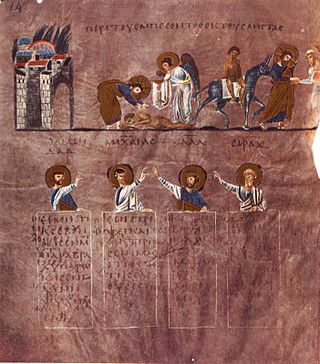
Purple parchment or purple vellum refers to parchment dyed purple; codex purpureus refers to manuscripts written entirely or mostly on such parchment. The lettering may be in gold or silver. Later the practice was revived for some especially grand illuminated manuscripts produced for the emperors in Carolingian art and Ottonian art, in Anglo-Saxon England and elsewhere. Some just use purple parchment for sections of the work; the 8th-century Anglo-Saxon Stockholm Codex Aureus alternates dyed and un-dyed pages.

Gothic is an extinct East Germanic language that was spoken by the Goths. It is known primarily from the Codex Argenteus, a 6th-century copy of a 4th-century Bible translation, and is the only East Germanic language with a sizeable text corpus. All others, including Burgundian and Vandalic, are known, if at all, only from proper names that survived in historical accounts, and from loanwords in other languages such as Portuguese, Spanish, Catalan, Occitan, and French.

Codex Carolinus is an uncial manuscript of the New Testament on parchment, dated to the 6th or 7th century. It is a palimpsest containing a Latin text written over a Gothic one. The Gothic text is designated by siglum Car, the Latin text is designated by siglum gue or by 79, it represents the Old Latin translation of the New Testament. It is housed in the Herzog August Library in Wolfenbüttel in Lower Saxony, Germany.

The Euthalian Apparatus is a collection of additional editorial material, such as divisions of text, lists, and summaries, to the New Testament's Book of Acts, Catholic epistles, and Pauline epistles. This additional material appears at the beginnings of books, in the margin of the text, and at the ends of books, as well as in line and paragraph separations. This material is traditionally associated with the name of Euthalius.

The Emperor's Bible, also known as Codex Caesareus, Codex Caesareus Upsaliensis or the Goslar Gospels, is an 11th-century illuminated manuscript currently in Uppsala University Library, Sweden. Despite its name, it is not a Bible but a Gospel Book. The book was made in the scriptorium of Echternach Abbey, and is one of four preserved large Gospel Books made there during the 11th century. It was commissioned by Emperor Henry III and donated by him to Goslar Cathedral, where it remained until the Thirty Years' War. It was then lost for about 100 years. Its previous richly decorated cover was also lost at this time at the latest. The book later appeared again in the possession of Swedish diplomat and civil servant Gustaf Celsing the Elder. At the death of his son, it was acquired by Uppsala University.
